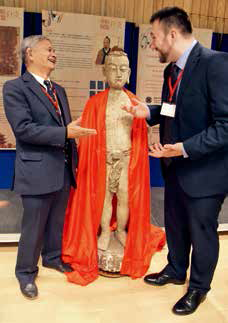Belt and Road Reconstructing and Nourishing Globalization

China is striving to enhance opening up in all areas and promote connectivity. By doing so, it hopes to pay forward the dividends the country has received from its reform and opening up to facilitate the process of globalization. China’s reform and opening up first started in 1978. Regardless of ups and downs in domestic and international situations and fluctuations in the world economy over the past 40 years, China has steadfastly adhered to the path of reform and opening up. In retrospect, it is easy to see that the more development China’s economy seizes, the more open China becomes and the more channels to participate in globalization it finds.
In 2013, Chinese President Xi Jinping proposed the Belt and Road Initiative, which turned a new page on China’s opening up to the outside world. After advancing steadily for years, work within the initiative has progressed from the top-level design to planned practice and now all-round development. In the long term, the step-by-step implementation of the initiative will further deepen China’s reform and opening up and in particular update the mode of the country’s opening up, facilitating a wider embrace to the world.
The Belt and Road Initiative helps reconstruct patterns of China’s opening up to the outside world.
At a meeting commemorating the initiative’s fifth anniversary, Xi pointed out that the implementation of the Belt and Road Initiative has greatly promoted the liberalization and facilitation of China’s trade and investment and made new ground for opening China further through links running eastward and westward, across land and over sea. The new patterns represent not only achievements of the initiative over the past five years, but also the direction of China’s future opening up. In the early days of China’s reform and opening up, limitations in terms of natural resources, geographical condition, economic development level and industrial distribution caused China’s western and central parts to severely lag behind the eastern regions in terms of the degree of openness. So, connectivity of infrastructure, which is underlined by the initiative, plays a key role in solving this imbalance. Advancement of the initiative, led by infrastructural links, will open a channel from China’s western and central regions to central Asian countries, promoting a smooth flow of trade, capital and personnel, which can help balance China’s various regions in the degree of openness to the outside world.

The Belt and Road Initiative represents an upgraded version of China’s opening up to the outside world.
Over the past five years since the initiative was proposed, trade in goods between China and other countries along the Belt and Road routes has amounted to US$5 trillion accumulatively, while China’s outward foreign direct investments in those countries have exceeded US$60 billion. Compared to 40 years ago when China merely earned foreign exchange from exports, the country’s opening up has now been largely independent from exported commodities. Especially since the introduction of the principles of “policy coordination, infrastructure connectivity, unimpeded trade, financial integration and closer people-to-people ties,” China has transformed from a simple exporter to the global nexus as it has become more closely connected to the world in various ways. More importantly, after 40 years of reform and opening up, China has evolved from a “world factory” to a “world market.” The enormous market of 1.3 billion consumers provides countries along the Belt and Road routes and even the world with historic chances to expand export and investment to China.
The Belt and Road Initiative has redesigned the concept of China’s opening up to the outside world.
On many occasions, Xi has emphasized that the initiative does not aim at a geopolitical or military alliance, nor will it establish a small bloc or set up a “China club.” Over the past five years, the initiative has achieved fruitful results, which evidences that China’s ongoing reform has undergone a paradigm shift and idea reconstruction. More than encouraging economic cooperation, the initiative serves as an important path to improve global growth modes and governance as well as promote the healthy development of economic globalization.
With increasing infrastructural connectivity, China will engage in greater economic and trade communication, wider policy coordination and more solid strategic alignment. The Belt and Road Initiative will no doubt tighten the connection between China and the world. In contrast with the past, China now has the ability to offer original programs such as railway construction, cross-border e-commerce platforms like Tmall Global, worldwide logistics networks such as Cainiao Global Logistics and mobile payment titans like Alipay. China is striving to enhance opening up in all areas and promote connectivity. By doing so, it hopes to pay forward the dividends the country received from its reform and opening up to facilitate the process of globalization.
The author is a professor at the University of International Relations and a researcher with China Digital Economy Institute.